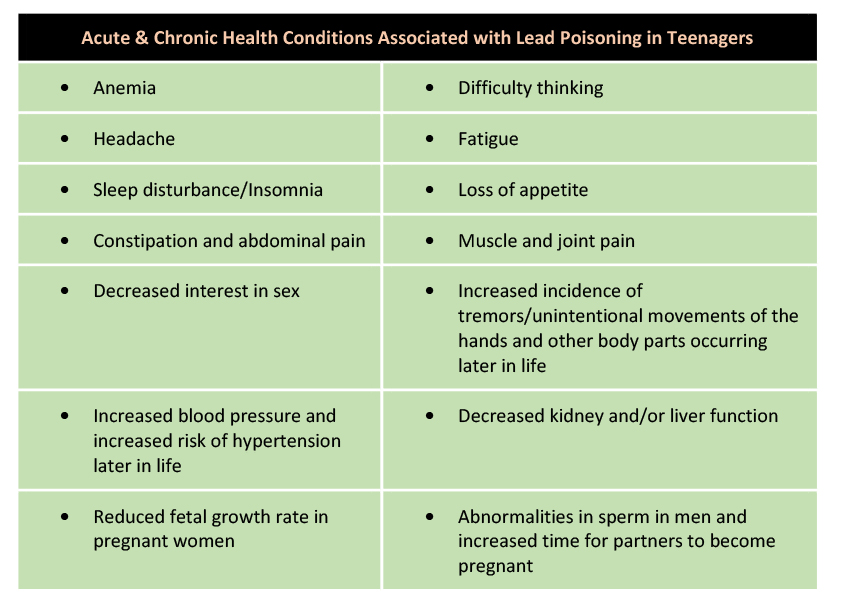Disclaimer: The American Academy of Pediatrics (AAP) strongly supports regulations that reduce children's access to firearms, and reminds parents that the safest home for a child is a home without guns.
AAP policy further urges that military weapons (assault weapons and high-capacity ammunition magazines) be banned from civilian use. We recommend firearms be removed from the environments where children live and play, but if they are not, they must be stored locked and unloaded. The AAP supports funding programs to remove lead hazards from the environment.
In many parts of the country, it is common for teens to participate in school pistol and rifle clubs, compete in shooting sports, participate in JROTC, or work at indoor firing ranges.
Lead poisoning has long been associated with firearms. Numerous studies since the 1970s have found high blood lead levels (BLLs) among people who use or work in indoor firing ranges – including teens and young adults.
While an extensive effort is made to prevent environmental lead exposure in young children and toddlers, this article sheds light on the lead dangers associated with recreational shooting.
How Does Lead Get Into the Air?
Ammunition contains lead. Lead is released into the air when the gun is fired. These particles of lead can get into the body when someone breathes them in. Additionally, they can get into the body if someone eats or drinks after shooting (or working) and does not wash their hands first.
Who Is At Risk?
Employees
Those at greatest risk for lead poisoning are employees who are involved in cleaning the indoor range, particularly if this involves sweeping or vacuuming lead containing dust without the use of protective equipment such as gloves and a respiratory filter that will prevent the inhalation of lead dust.
-
Example: The highest BLLs ever recorded by the Baltimore City Health Department were in an attendant who regularly swept up in an amusement park shooting gallery.
Shooters
Standard recreational and competitive shooters who use indoor firing ranges are also at risk.
-
Example: In 1999, Boston Children's Hospital reported the cases of four teenage girls with elevated BLLs, all of whom were competitive shooters at an indoor firing range.
Health Effects from Lead Exposure
Teens and young adults should keep their lead exposure as low as possible. The Centers for Disease Control and Prevention (CDC) considers a BLL greater than 10 μg/dL as representing undue lead exposure. If not detected early, people with elevated BLLs can suffer from a variety of health effects that can be permanent and irreversible.
See chart below.

How to Minimize Your Teen's Risk of Lead Poisoning
If your teen must shoot at an indoor firing range, use the following precautions:
Make sure the range has a routine cleaning and maintenance plan that includes wet cleaning instead of dry sweeping and utilizing a HEPA (High Efficiency Particulate Air) vacuum instead of a shop vacuum.
Make sure the range has a dedicated exhaust ventilation system.
Remind your teen not to eat or drink while shooting. After shooting, he should wash his hands and face thoroughly with cold, soapy water, especially before eating or drinking. The cold water closes the pores of your skin, and prevents the washing of lead particles into the pores.
Encourage your teen to wear a respirator when shooting. If she finds that wearing a full respirator makes it impossible to talk and to be heard in the range, suggest using one of the disposable paper masks rated for fine dust and paint overspray.
Make sure he wears an outer garment that can be removed and washed after each range session or left in a locker. Likewise, remind him to bring an extra pair of shoes to change into after leaving the range. If he does come home wearing the same outer clothes, make sure he changes them immediately, and puts them in the washer
(separate from other clothes).
Urge your teen to avoid loading her own ammunition. Teens are at a greater risk for lead exposure if they load their own ammunition. Suggest she try using copper-jacketed bullets.
Teens who work in shooting ranges should follow all applicable OSHA guidance, including careful supervision regarding the use of personal, protective gear and procedures
(mentioned above).
The concern about lead poisoning in teens involved in these activities does not mean that they should be forbidden from participating. It is important to create a safe environment where these activities can be practiced with decreased risk, and establish BLL monitoring programs for the teens involved. Parents should discuss the BLL test results with their child's pediatrician.
Additional Information: